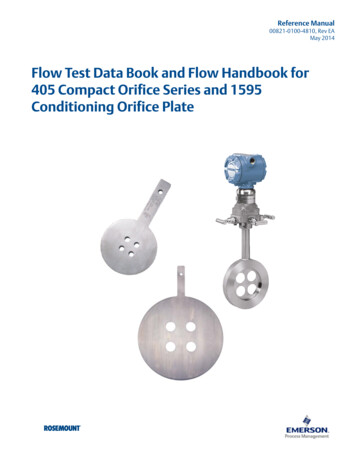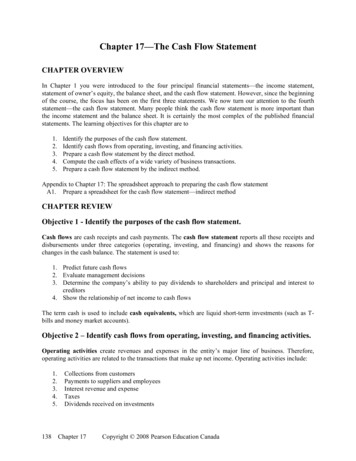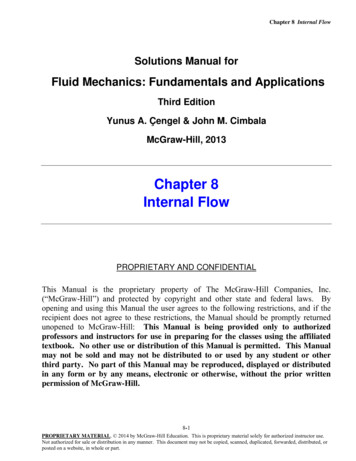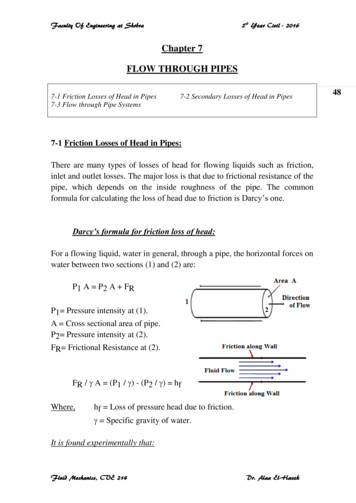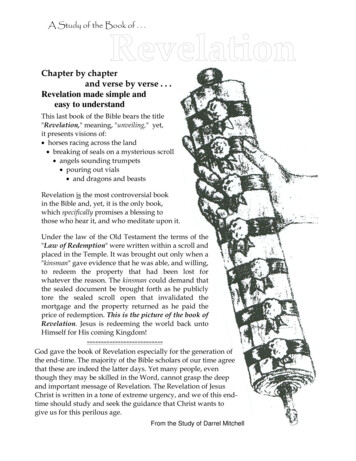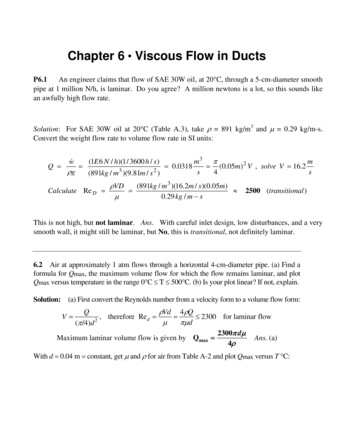
Transcription
Chapter 6 Viscous Flow in DuctsP6.1An engineer claims that flow of SAE 30W oil, at 20 C, through a 5-cm-diameter smoothpipe at 1 million N/h, is laminar. Do you agree? A million newtons is a lot, so this sounds likean awfully high flow rate.Solution: For SAE 30W oil at 20 C (Table A.3), take ρ 891 kg/m3 and μ 0.29 kg/m-s.Convert the weight flow rate to volume flow rate in SI units:(1E 6 N / h)(1 / 3600 h / s )w m3 πmQ 0.0318 (0.05m) 2 V , solve V 16.232ρgs4s(891kg / m )(9.81m / s )Calculate Re DρVD(891kg / m 3 )(16.2m / s )(0.05m) μ0.29 kg / m s2500 (transitional )This is not high, but not laminar. Ans. With careful inlet design, low disturbances, and a verysmooth wall, it might still be laminar, but No, this is transitional, not definitely laminar.6.2 Air at approximately 1 atm flows through a horizontal 4-cm-diameter pipe. (a) Find aformula for Qmax, the maximum volume flow for which the flow remains laminar, and plotQmax versus temperature in the range 0 C T 500 C. (b) Is your plot linear? If not, explain.Solution: (a) First convert the Reynolds number from a velocity form to a volume flow form:QρVd 4ρQ 2300 for laminar flow, therefore Re d 2μπμ d(π /4)d2300π dμMaximum laminar volume flow is given by Q max Ans. (a)4ρV With d 0.04 m constant, get μ and ρ for air from Table A-2 and plot Qmax versus T C:
Chapter 6 Viscous Flow in Ducts435Fig. P6.2The curve is not quite linear because ν μ/ρ is not quite linear with T for air in thisrange. Ans. (b)6.3 For a thin wing moving parallel to its chord line, transition to a turbulent boundarylayer occurs at a “local” Reynolds number Rex, where x is the distance from the leadingedge of the wing. The critical Reynolds number depends upon the intensity of turbulentfluctuations in the stream and equals 2.8E6 if the stream is very quiet. A semiempiricalcorrelation for this case [Ref. 3 of Ch. 6] isRe1/2xcrit 1 (1 13.25ζ 2 )1/20.00392ζ 2where ζ is the tunnel-turbulence intensity in percent. If V 20 m/s in air at 20 C, use thisformula to plot the transition position on the wing versus stream turbulence for ζ between0 and 2 percent. At what value of ζ is xcrit decreased 50 percent from its value at ζ 0?Solution: This problem is merely to illustrate the strong effect of stream turbulence onthe transition point. For air at 20 C, take ρ 1.2 kg/m3 and μ 1.8E 5 kg/m s. ComputeRex,crit from the correlation and plot xtr μRex/[ρ(20 m/s)] versus percent turbulence:
436Solutions Manual Fluid Mechanics, Fifth EditionFig. P6.3The value of xcrit decreases by half (to 1.07 meters) at ζ 0.42%.Ans.6.4 For flow of SAE 30 oil through a 5-cm-diameter pipe, from Fig. A.1, for what flowrate in m3/h would we expect transition to turbulence at (a) 20 C and (b) 100 C?Solution: For SAE 30 oil take ρ 891 kg/m 3 and take μ 0.29 kg/m s at 20 C (Table A.3)and 0.01 kg/m-s at 100 C (Fig A.1). Write the critical Reynolds number in terms of flowrate Q:ρVD 4ρQ4(891 kg/m3 )Q (a) Re crit 2300 ,μπμ D π (0.29 kg/m s)(0.05 m)m3m3solve Q 0.0293 106Ans. (a)hsρVD 4ρQ4(891 kg/m3 )Q(b) Re crit 2300 , μπμ D π (0.010 kg/m s)(0.05 m)m3m3 3.6solve Q 0.00101shAns. (b)
Chapter 6 Viscous Flow in Ducts6.5 In flow past a body or wall, earlytransition to turbulence can be induced byplacing a trip wire on the wall across theflow, as in Fig. P6.5. If the trip wire inFig. P6.5 is placed where the local velocityis U, it will trigger turbulence if Ud/ν 850,where d is the wire diameter [Ref. 3 of Ch. 6].If the sphere diameter is 20 cm and transitionis observed at ReD 90,000, what is thediameter of the trip wire in mm?437Fig. P6.5Solution: For the same U and ν,UdUDRe d 850; Re D 90000,νor d DνRe d 850 (200 mm) 1.9 mm 90000 Re DP6.6For flow of a uniform stream parallel to a sharp flat plate, transition to a turbulentboundary layer on the plate may occur at Rex ρUx/μ 1E6, where U is the approach velocityand x is distance along the plate. If U 2.5 m/s, determine the distance x for the following fluidsat 20 C and 1 atm: (a) hydrogen; (b) air; (c) gasoline; (d) water; (e) mercury; and (f) glycerin.Solution: We are to calculate x (Rex)(μ)/(ρU) (1E6)(μ)/[ρ (2.5m/s)]. Make a table:FLUIDρ – kg/m3μ - kg/m-sx - asoline6802.92E-40.17Water9980.00100.40
Solutions Manual Fluid Mechanics, Fifth 6470.Clearly there are vast differences between fluid properties and their effects on flows.6.7 Cola, approximated as pure water at 20 C, is to fill an 8-oz container (1 U.S. gal 128 fl oz) through a 5-mm-diameter tube. Estimate the minimum filling time if the tubeflow is to remain laminar. For what cola (water) temperature would this minimum timebe 1 min?Solution: For cola “water”, take ρ 998 kg/m3 and μ 0.001 kg/m s. Convert 8 fluidounces (8/128)(231 in3) 2.37E 4 m3. Then, if we assume transition at Re 2300,Re crit 2300 ρ VD 4 ρ Q2300π (0.001)(0.005)m3, or: Q crit 9.05E 64(998)sμπμ DThen Δtfill υ/Q 2.37E 4/9.05E 6 26 s Ans. (a)(b) We fill in exactly one minute if Qcrit 2.37E 4/60 3.94E 6 m3/s. ThenQ crit 3.94E 6m 3 2300πν D s4if ν water 4.36E 7 m 2 /sFrom Table A-1, this kinematic viscosity occurs at T 66 C Ans. (b)6.8 When water at 20 C (ρ 998 kg/m3, μ 0.001 kg/m s) flows through an 8-cmdiameter pipe, the wall shear stress is 72 Pa. What is the axial pressure gradient ( p/ x)if the pipe is (a) horizontal; and (b) vertical with the flow up?Solution: Equation (6.9b) applies in both cases, noting that τw is negative:(a) Horizontal:(b) Vertical, up:dp 2τ w 2( 72 Pa )Pa 3600dxRm0.04 mAns. (a)dp 2τ wdz 1Pa 3600 998(9.81) 13, 400 ρgdxRdxmAns. (b)
Chapter 6 Viscous Flow in Ducts4396.9 A light liquid (ρ 950 kg/m3) flows at an average velocity of 10 m/s through ahorizontal smooth tube of diameter 5 cm. The fluid pressure is measured at 1-m intervalsalong the pipe, as follows:x, m:p, kPa:0304127322553240422652136200Estimate (a) the total head loss, in meters; (b) the wall shear stress in the fully developedsection of the pipe; and (c) the overall friction factor.Solution: As sketched in Fig. 6.6 of the text, the pressure drops fast in the entranceregion (31 kPa in the first meter) and levels off to a linear decrease in the “fullydeveloped” region (13 kPa/m for this data).(a) The overall head loss, for Δz 0, is defined by Eq. (6.8) of the text:hf Δp 304,000 200,000 Pa 11.2 mρ g (950 kg/m 3 )(9.81 m/s 2 )Ans. (a)(b) The wall shear stress in the fully-developed region is defined by Eq. (6.9b):Δp fully developed 13000 Pa 4τ w 4τ w , solve for τ w 163 PaΔL1m0.05 mdAns. (b)(c) The overall friction factor is defined by Eq. (6.10) of the text:foverall h f , overall2d 2g 0.05 m 2(9.81 m/s ) (11.2 m) 0.0182 2L V2 6 m (10 m/s)Ans. (c)NOTE: The fully-developed friction factor is only 0.0137.6.10 Water at 20 C (ρ 998 kg/m3) flows through an inclined 8-cm-diameter pipe. Atsections A and B, pA 186 kPa, VA 3.2 m/s, zA 24.5 m, while pB 260 kPa, VB 3.2m/s, and zB 9.1 m. Which way is the flow going? What is the head loss?BBSolution: Guess that the flow is from A to B and write the steady flow energy equation:pA VA2pV2186000260000 z A B B zB h f , or: 24.5 9.1 h f ,ρg 2 gρg 2 g97909790or: 43.50 35.66 h f , solve: h f 7.84 m Yes, flow is from A to B. Ans. (a, b)
Solutions Manual Fluid Mechanics, Fifth Edition4406.11 Water at 20 C flows upward at 4 m/s in a 6-cm-diameter pipe. The pipe lengthbetween points 1 and 2 is 5 m, and point 2 is 3 m higher. A mercury manometer,connected between 1 and 2, has a reading h 135 mm, with p1 higher. (a) What is thepressure change (p1 p2)? (b) What is the head loss, in meters? (c) Is the manometer readingproportional to head loss? Explain. (d) Whatis the friction factor of the flow?Solution: A sketch of this situation isshown at right. By moving through themanometer, we obtain the pressure changebetween points 1 and 2, which we comparewith Eq. (6.9b):p1 γ w h γ m h γ w Δz p2 ,or:N N p1 p2 133100 9790 3 (0.135 m) 9790 3 (3 m) m m 16650 29370 46,000 PaFrom Eq. (6.9b), h f The friction factor isΔpγwf hf Δz Ans. (a)46000 Pa 3 m 4.7 3.0 1.7 m9790 N /m3Ans. (b)2d 2g 0.06 m 2(9.81 m/s ) (1.7m) 0.025 L V25 m (4 m/s)2Ans. (d)By comparing the manometer relation to the head-loss relation above, we find that:hf (γ m γ w )γwh and thus head loss is proportional to manometer reading. Ans. (c)NOTE: IN PROBLEMS 6.12 TO 6.99, MINOR LOSSES ARE NEGLECTED.6.12 A 5-mm-diameter capillary tube is used as a viscometer for oils. When the flowrate is 0.071 m3/h, the measured pressure drop per unit length is 375 kPa/m. Estimate theviscosity of the fluid. Is the flow laminar? Can you also estimate the density of the fluid?Solution: Assume laminar flow and use the pressure drop formula (6.12):Δp ? 8QμPa ? 8(0.071/3600)μkg , or: 375000 , solve μ 0.29244L πRmm sπ (0.0025)Ans.
Chapter 6 Viscous Flow in DuctskgGuessing ρoil 900 3 ,m4ρQ 4(900)(0.071/3600)check Re 16 OK, laminarπμdπ (0.292)(0.005)441Ans.It is not possible to find density from this data, laminar pipe flow is independent of density.6.13 A soda straw is 20 cm long and 2 mm in diameter. It delivers cold cola,approximated as water at 10 C, at a rate of 3 cm3/s. (a) What is the head loss through thestraw? What is the axial pressure gradient p/ x if the flow is (b) vertically up or(c) horizontal? Can the human lung deliver this much flow?Solution: For water at 10 C, take ρ 1000 kg/m3 and μ 1.307E 3 kg/m s. Check Re:Re 4 ρ Q 4(1000)(3E 6 m3 /s) 1460 (OK, laminar flow)πμ d π (1.307E 3)(0.002)Then, from Eq. (6.12), h f 128μLQ 128(1.307E 3)(0.2)(3E 6) 0.204 mπρgd 4π (1000)(9.81)(0.002)4Ans. (a)If the straw is horizontal, then the pressure gradient is simply due to the head loss:Δp horiz ρghf 1000(9.81)(0.204 m) 9980 PaLL0.2 mmAns. (c)If the straw is vertical, with flow up, the head loss and elevation change add together:Δp vertical ρg(h f Δz) 1000(9.81)(0.204 0.2) 19800 PaLL0.2mAns. (b)The human lung can certainly deliver case (c) and strong lungs can develop case (b) also.
Solutions Manual Fluid Mechanics, Fifth Edition4426.14 Water at 20 C is to be siphonedthrough a tube 1 m long and 2 mm indiameter, as in Fig. P6.14. Is there anyheight H for which the flow might not belaminar? What is the flow rate if H 50 cm?Neglect the tube curvature.Fig. P6.14Solution: For water at 20 C, take ρ 998 kg/m3 and μ 0.001 kg/m s. Write the steadyflow energy equation between points 1 and 2 above:patm 02pV2V232 μ LV z1 atm tube z 2 h f , or: H hf 2g2gρg 2gρgρgd 2Enter data in Eq. (1): 0.5 (1)V232(0.001)(1.0)Vm , solve V 0.59022(9.81) (998)(9.81)(0.002)sEquation (1) is quadratic in V and has only one positive root. The siphon flow rate isπm3m3Q H 50 cm (0.002) (0.590) 1.85E 6 0.0067if H 50 cm Ans.4shCheck Re (998)(0.590)(0.002) /(0.001) 1180 (OK, laminar flow)2It is possible to approach Re 2000 (possible transition to turbulent flow) for H 1 m,for the case of the siphon bent over nearly vertical. We obtain Re 2000 at H 0.87 m.6.15 Professor Gordon Holloway and his students at the University of New Brunswickwent to a fast-food emporium and tried to drink chocolate shakes (ρ 1200 kg/m3,μ 6 kg/m s) through fat straws 8 mm in diameter and 30 cm long. (a) Verify that theirhuman lungs, which can develop approximately 3000 Pa of vacuum pressure, would beunable to drink the milkshake through the vertical straw. (b) A student cut 15 cm from hisstraw and proceeded to drink happily. What rate of milkshake flow was produced by thisstrategy?Solution: (a) Assume the straw is barely inserted into the milkshake. Then the energyequation predicts2p1 V1p2 V22 z z hfρg 2 g 1 ρg 2 g 2 0 0 0 V 2tube( 3000 Pa) 0.3 m h f(1200 kg/m3 )(9.81 m/s 2 ) 2 gSolve for h f 0.255 m 0.3 m V2tube 0 which is impossible2gAns. (a)
Chapter 6 Viscous Flow in Ducts443(b) By cutting off 15 cm of vertical length and assuming laminar flow, we obtain a newenergy equationh f 0.255 0.15 V 2 32 μ LVV232(6.0)(0.15)V0.105m 38.23V22g2(9.81) (1200)(9.81)(0.008)2ρgdSolve for V 0.00275 m/s, Q AV (π /4)(0.008)2 (0.00275)cm 3m3Q 1.4 E 7 0.14Ans. (b)ssCheck the Reynolds number: Red ρVd/μ (1200)(0.00275)(0.008)/(6) 0.0044 (Laminar).6.16 Glycerin at 20 C is to be pumped through a horizontal smooth pipe at 3.1 m3/s. Itis desired that (1) the flow be laminar and (2) the pressure drop be no more than 100 Pa/m.What is the minimum pipe diameter allowable?Solution: For glycerin at 20 C, take ρ 1260 kg/m3 and μ 1.49 kg/m s. We have twodifferent constraints to satisfy, a pressure drop and a Reynolds number:Δp 128μQPa 100Lmπ d4(1);128(1.49)(3.1) 100, d 1.17 m,π d44 ρQ 2000πμd(2);4(1260)(3.1) 2000, d 1.67 mπ (1.49)dor: Re The second of these is more restrictive. Thus the proper diameter is d 1.67 m. Ans.6.17 A capillary viscometer measures thetime required for a specified volume υ ofliquid to flow through a small-bore glasstube, as in Fig. P6.17. This transit time isthen correlated with fluid viscosity. For thesystem shown, (a) derive an approximateformula for the time required, assuminglaminar flow with no entrance and exitlosses. (b) If L 12 cm, l 2 cm, υ 8 cm3,and the fluid is water at 20 C, whatcapillary diameter D will result in a transittime t of 6 seconds?Fig. P6.17
444Solutions Manual Fluid Mechanics, Fifth EditionSolution: (a) Assume no pressure drop and neglect velocity heads. The energy equationreduces to:p1 V12pV2 z1 0 0 ( L l ) 2 2 z2 h f 0 0 0 h f , or: h f L lρ g 2gρ g 2gFor laminar flow, h f 128μ LQπρgd 4Solve for Δt and, for uniform draining, Q 128 μ Lυπρ gd 4 ( L l )υΔtAns. (a)(b) Apply to Δt 6 s. For water, take ρ 998 kg/m3 and μ 0.001 kg/m s. Formula (a) predicts:Δt 6 s 128(0.001 kg/m s)(0.12 m)(8E 6 m3 ),π (998 kg/m3 )(9.81 m/s2 )d 4 (0.12 0.02 m)Solve for d 0.0015 mAns. (b)6.18 To determine the viscosity of aliquid of specific gravity 0.95, you fill, to adepth of 12 cm, a large container whichdrains through a 30-cm-long vertical tubeattached to the bottom. The tube diameteris 2 mm, and the rate of draining is foundto be 1.9 cm3/s. What is your estimate ofthe fluid viscosity? Is the tube flow laminar?Fig. P6.18Solution: The known flow rate and diameter enable us to find the velocity in the tube:V Q1.9 E 6 m 3 /sm 0.6052A (π /4)(0.002 m)sEvaluate ρ liquid 0.95(998) 948 kg/m3. Write the energy equation between the top surfaceand the tube exit:2pa Vtopp V2 ztop a 0 hf ,ρg 2 gρg 2 gV 2 32μ LV (0.605)232μ (0.3)(0.605) or: 0.42 22g2(9.81) 948(9.81)(0.002)2ρgd
Chapter 6 Viscous Flow in Ducts445Note that “L” in this expression is the tube length only (L 30 cm).kg(laminar flow) Ans.m sρVd 948(0.605)(0.002)Red 446 (laminar )μ0.00257Solve for μ 0.002576.19 An oil (SG 0.9) issues from thepipe in Fig. P6.19 at Q 35 ft3/h. What isthe kinematic viscosity of the oil in ft3/s? Isthe flow laminar?Solution: Apply steady-flow energy:patm 02pV2 z1 atm 2 z 2 h f ,ρg 2gρg 2gwhere V2 Fig. P6.19Q35/3600ft 7.132A π (0.25 /12)sSolve h f z1 z2 V22(7.13)2 10 9.21 ft2g2(32.2)Assuming laminar pipe flow, use Eq. (6.12) to relate head loss to viscosity:128ν LQ 128(6)(35/3600)νμft 2h f 9.21 ft , solve ν 3.76E 4 ρsπ gd 4π (32.2)(0.5/12)4Ans.Check Re 4Q/(πν d) 4(35/3600)/[π (3.76E 4)(0.5/12)] 790 (OK, laminar)P6.20 The oil tanks in Tinyland are only 160 cm high, and they discharge to the Tinyland oiltruck through a smooth tube 4 mm in diameter and 55 cm long. The tube exit is open to theatmosphere and 145 cm below the tank surface. The fluid is medium fuel oil, ρ 850 kg/m3 andμ 0.11 kg/m-s. Estimate the oil flow rate in cm3/h.Solution: The steady flow energy equation, with 1 at the tank surface and 2 the exit, gives
Solutions Manual Fluid Mechanics, Fifth Edition446z1 z 2 αV 22g fV2850V (0.004)LV264 0.55m) , Re d , or : Δz 1.45m (2.0 0.11d 2gRe d 0.004m2gWe have taken the energy correction factor α 2.0 for laminar pipe flow.Solve for V 0.10 m/s, Red 3.1 (laminar), Q 1.26E-6 m3/s 4500 cm3/h.The exit jet energy αV2/2g is properly included but is very small (0.001 m).6.21 In Tinyland, houses are less than afoot high! The rainfall is laminar! Thedrainpipe in Fig. P6.21 is only 2 mm indiameter. (a) When the gutter is full, whatis the rate of draining? (b) The gutter isdesigned for a sudden rainstorm of up to5 mm per hour. For this condition, what isthe maximum roof area that can be drainedsuccessfully? (c) What is Red?Solution: If the velocity at the guttersurface is neglected, the energy equationreduces toΔz V232 μ LV h f , where h f ,laminar 2gρ gd 2Fig. P6.21For water, take ρ 998 kg/m3 and μ 0.001 kg/m s. (a) With Δz known, this is aquadratic equation for the pipe velocity V:V232(0.001 kg/m s)(0.2 m )V ,22(9.81 m/s ) (998 kg/m3 )(9.81 m/s2 )(0.002 m )2mor: 0.051V 2 0.1634V 0.2 0, Solve for V 0.945 ,s33πmm m 0.0107Q (0.002 m)2 0.945 2.97E 6Ans. (a) h4s s0.2 m Ans.
Chapter 6 Viscous Flow in Ducts447(b) The roof area needed for maximum rainfall is 0.0107 m3/h 0.005 m/h 2.14 m2. Ans. (b)(c) The Reynolds number of the gutter is Red (998)(0.945)(0.002)/(0.001) 1890laminar. Ans. (c)6.22 A steady push on the piston in Fig. P6.22 causes a flow rate Q 0.15 cm3/sthrough the needle. The fluid has ρ 900 kg/m3 and μ 0.002 kg/(m s). What force F isrequired to maintain the flow?Fig. P6.22Solution: Determine the velocity of exit from the needle and then apply the steady-flowenergy equation:V1 Energy:Q0.15 306 cm/sA (π /4)(0.025)2p2 V22pV2 z 2 1 1 z1 h f1 h f2 , with z1 z 2 , V2 0, h f2 0ρg 2gρg 2gAssume laminar flow for the head loss and compute the pressure difference on the piston:p2 p1V12 32(0.002)(0.015)(3.06) (3.06)2 h f1 5.79 m2g (900)(9.81)(0.00025)2 2(9.81)ρgπThen F ΔpA piston (900)(9.81)(5.79) (0.01)2 4.0 N4Ans.6.23 SAE 10 oil at 20 C flows in a vertical pipe of diameter 2.5 cm. It is found that thepressure is constant throughout the fluid. What is the oil flow rate in m3/h? Is the flow upor down?Solution: For SAE 10 oil, take ρ 870 kg/m3 and μ 0.104 kg/m s. Write the energyequation between point 1 upstream and point 2 downstream:p1 V12pV2 z1 2 2 z 2 h f , with p1 p2 and V1 V2ρg 2gρg 2g
Solutions Manual Fluid Mechanics, Fifth Edition448Thus h f z1 z2 0 by definition. Therefore, flow is down. Ans.While flowing down, the pressure drop due to friction exactly balances the pressure risedue to gravity. Assuming laminar flow and noting that Δz L, the pipe length, we gethf or: Q 128μ LQ Δz L,πρgd 4π (8.70)(9.81)(0.025)4128(0.104) 7.87E 4m3m3 2.83hsAns.6.24 Two tanks of water at 20 C are connected by a capillary tube 4 mm in diameterand 3.5 m long. The surface of tank 1 is 30 cm higher than the surface of tank 2.(a) Estimate the flow rate in m3/h. Is the flow laminar? (b) For what tube diameter willRed be 500?Solution: For water, take ρ 998 kg/m3 and μ 0.001 kg/m s. (a) Both tank surfacesare at atmospheric pressure and have negligible velocity. The energy equation, whenneglecting minor losses, reduces to:Δz 0.3 m h f 128μ LQ128(0.001 kg/m s)(3.5 m)Q 4πρgdπ (998 kg/m3 )(9.81 m/s2 )(0.004 m)4m3m3Solve for Q 5.3E 6 0.019shAns. (a)Check Re d 4 ρQ/(πμ d ) 4(998)(5.3E 6)/[π (0.001)(0.004)]Re d 1675 laminar. Ans. (a)(b) If Red 500 4ρQ/(πμd) and Δz hf, we can solve for both Q and d:4(998 kg/m3 )QRe d 500 , or Q 0.000394dπ (0.001 kg/m s)dh f 0.3 m 128(0.001 kg/m s)(3.5 m)Q, or Q 20600d 4324π (998 kg/m )(9.81 m/s )dCombine these two to solve for Q 1.05E 6 m 3 /s andd 2.67 mmAns. (b)
Chapter 6 Viscous Flow in Ducts4496.25 For the configuration shown inFig. P6.25, the fluid is ethyl alcohol at20 C, and the tanks are very wide. Find theflow rate which occurs in m3/h. Is the flowlaminar?Solution: For ethanol, take ρ 789 kg/m3 and μ 0.0012 kg/m s. Writethe energy equation from upper freesurface (1) to lower free surface (2):Fig. P6.25p1 V12pV2 z1 2 2 z 2 h f , with p1 p2 and V1 V2 0ρg 2gρg 2g128μ LQ 128(0.0012)(1.2 m)Q Then h f z1 z 2 0.9 m πρgd 4π (789)(9.81)(0.002)4Solve for Q 1.90E 6 m 3 /s 0.00684 m 3 /h.Ans.Check the Reynolds number Re 4ρQ/(πμd) 795 OK, laminar flow.za 22 mP6.26 Two oil tanks are connected byzb 15 mtwo 9-m-long pipes, as in Fig. P6.26.D1 5 cmPipe 1 is 5 cm in diameter and is 6 mhigher than pipe 2. It is found that theSAE30Woil atflow rate in pipe 2 is twice as large asD2L 9m20 Cthe flow in pipe 1. (a) What is the diameterFig. P6.26of pipe 2? (b) Are both pipe flows laminar?(c) What is the flow rate in pipe 2 (m3/s)?6m
Solutions Manual Fluid Mechanics, Fifth Edition450Neglect minor losses.Solution: (a) If we know the flows are laminar, and (L, ρ, μ) are constant, then Q D4:Q2D 2.0 ( 2 ) 4 , hence D2 (5 cm)(2.0)1 / 4 5.95 cm Ans.(a )Q1D1We will check later in part (b) to be sure the flows are laminar. [Placing pipe 1 sixFrom Eq. (6.12),meters higher was meant to be a confusing trick, since both pipes have exactly the samehead loss and Δz.](c) Find the flow rate first and then backtrack to the Reynoldsnumbers. For SAE 30W oil at 20 C (Table A.3), take ρ 891 kg/m3 and μ 0.29 kg/ms. From the energy equation, with V1 V2 0, and Eq. (6.12) for the laminar head loss,Δz 22 15 7 m h f 128μLQπρgD24Solve for 128(0.29kg / m s)(9m) Q2π (891kg / m 3 )(9.81m / s 2 )(0.0595m) 4Q2 0.0072 m 3 /sAns.(c)In a similar manner, insert D1 0.05m and compute Q1 0.0036 m3/s (1/2)Q1.(b) Now go back and compute the Reynolds numbers:Re1 4 ρQ1 4(891)(0.0036)4 ρQ24(891)(0.0072) 281 ; Re 2 473 Ans.(b)πμD1 π (0.29)(0.050)πμD2 π (0.29)(0.0595)Both flows are laminar, which verifies our flashy calculation in part (a).
Chapter 6 Viscous Flow in Ducts4516.27 Let us attack Prob. 6.25 in symbolicfashion, using Fig. P6.27. All parametersare constant except the upper tank depth Z(t).Find an expression for the flow rate Q(t) asa function of Z(t). Set up a differentialequation, and solve for the time t0 to drainthe upper tank completely. Assume quasisteady laminar flow.Solution: The energy equation of Prob. 6.25,using symbols only, is combined with acontrol-volume mass balance for the tankto give the basic differential equation for Z(t):Fig. P6.27energy: h f 32μLVd π 2ππ h Z; mass balance:D Z d 2 L Q d 2 V,2 dt 444ρgd or:π4D2dZπρ gd 2 d 2 V, where V (h Z)dt432μ LSeparate the variables and integrate, combining all the constants into a single “C”:dZρ gd 4 Ct Cdt,or:Z(hZ)eh,whereCo h Z 32 μ LD2Zo0ZtTank drains completely when Z 0, at t 0 Z 1 ln 1 o C h Ans.Ans.
Solutions Manual Fluid Mechanics, Fifth Edition4526.28 For straightening and smoothing anairflow in a 50-cm-diameter duct, the ductis packed with a “honeycomb” of thin strawsof length 30 cm and diameter 4 mm, as inFig. P6.28. The inlet flow is air at 110 kPaand 20 C, moving at an average velocity of6 m/s. Estimate the pressure drop acrossthe honeycomb.Solution: For air at 20 C, take μ 1.8E 5 kg/m s and ρ 1.31 kg/m3. Therewould be approximately 12000 straws, buteach one would see the average velocity of6 m/s. ThusΔp laminar Fig. P6.2832μLV 32(1.8E 5)(0.3)(6.0) 65 Pad2(0.004)2Check Re ρVd/μ (1.31)(6.0)(0.004)/(1.8E 5) 1750Ans.OK, laminar flow.6.29 Oil, with ρ 890 kg/m3 and μ 0.07 kg/m s, flows through a horizontal pipe 15 mlong. The power delivered to the flow is 1 hp. (a) What is the appropriate pipe diameter ifthe flow is at the laminar transition point? For this condition, what are (b) Q in m3/h; and(c) τw in kPa?Solution: (a, b) Set the Reynolds number equal to 2300 and the (laminar) power equal to 1 hp:Re d 2300 (890 kg/m3 )Vd0.07 kg/m sor Vd 0.181 m 2 /s π 32 μ LV π Power 1 hp 745.7 W QΔplaminar d 2V 32(0.07)(15)V 2 4 d 2 4 mSolve for V 5.32and d 0.034 m Ans. (a)sIt follows that Q (π /4)d 2V (π /4)(0.034 m)2(5.32 m/s) 0.00484 m3/s 17.4 m3/h Ans. (b)(c) From Eq. (6.12), the wall shear stress isτw 8μV 8(0.07 kg/m s)(5.32 m/s) 88 Pa 0.088 kPad(0.034 m )Ans. (c)
Chapter 6 Viscous Flow in Ducts4536.30 SAE 10 oil at 20 C flows throughthe 4-cm-diameter vertical pipe ofFig. P6.30. For the mercury manometerreading h 42 cm shown, (a) calculate thevolume flow rate in m3/h, and (b) state thedirection of flow.Solution: For SAE 10 oil, take ρ 870 kg/m3 and μ 0.104 kg/m s. Thepressure at the lower point (1) isconsiderably higher than p2 according to themanometer reading:Fig. P6.30p1 p2 ( ρHg ρ oil )gΔh (13550 870)(9.81)(0.42) 52200 PaΔp/(ρoil g) 52200/[870(9.81)] 6.12 mThis is more than 3 m of oil, therefore it must include a friction loss: flow is up. Ans. (b)The energy equation between (1) and (2), with V1 V2, givesp1 p 2128μ LQ z 2 z1 h f , or 6.12 m 3 m h f , or: h f 3.12 m ρgπρ gd 4Compute Q (6.12 3)π (870)(9.81)(0.04)4m3m3 0.00536 19.3128(0.104)(3.0)shAns. (a)Check Re 4ρQ/(πμ d) 4(870)(0.00536)/[π (0.104)(0.04)] 1430 (OK, laminar flow).P6.31 A laminar flow element or LFE (Meriam Instrument Co.) measures low gas-flow rateswith a bundle of capillary tubes packed inside a large outer tube. Consider oxygen at 20 C and1 atm flowing at 84 ft3/min in a 4-in-diameter pipe. (a) Is the flow approaching the elementturbulent? (b) If there are 1000 capillary tubes, L 4 in, select a tube diameter to keep Redbelow 1500 and also to keep the tube pressure drop no greater than 0.5 lbf/in2. (c) Do the tubesselected in part (b) fit nicely within the approach pipe?Solution: For oxygen at 20 C and 1 atm (Table A.4), take R 260 m2/(s2K), hence ρ p/RT (101350Pa)/[260(293K)] 1.33 kg/m3 0.00258 slug/ft3. Also read μ 2.0E-5 kg/m-s 4.18E7 slug/ft-s. Convert Q 84 ft3/min 1.4 ft3/s. Then the entry pipe Reynolds number is
Solutions Manual Fluid Mechanics, Fifth Edition454Re D ρVD 4 ρQ4(0.00258slug / ft 3 )(1.4 ft 3 / s ) 33,000 ( turbulent) Ans.(a)μπμDπ (4.18E 7 slug / ft s)(4 / 12 ft )(b) To keep Red below 1500 and keep the (laminar) pressure drop no more than 72 psf (0.5 psi),Re d ρVd 1500 andμΔp 32 μLV 72lbf, where V Q / 1000d2ft 2(π / 4)d 2Select values of d and iterate, or use EES. The upper limit on Reynolds number givesRe d 1500ifd 0.00734 ft 0.088 in ;Δp 2.74 lbf / ft 2 Ans.(b)This is a satisfactory answer, since the pressure drop is no problem, quite small. Onethousand of these tubes would have an area about one-half of the pipe area, so would fitnicely. Ans.(c)Increasing the tube diameter would lower Red and have even smaller pressure drop.Example: d 0.01 ft, Red 1100, Δp 0.8 psf. These 0.01-ft-diameter tubes would justbarely fit into the larger pipe. One disadvantage, however, is that these tubes are short:the entrance length is longer than the tube length, and thus Δp will be larger thancalculated by “fully-developed” formulas.6.32 SAE 30 oil at 20 C flows in the 3cm-diameter pipe in Fig. P6.32, whichslopes at 37 . For the pressure measurements shown, determine (a) whether theflow is up or down and (b) the flow ratein m3/h.Solution: For SAE 30 oil, take ρ 891kg/m3 and μ 0.29 kg/m s. Evaluate thehydraulic grade lines:Fig. P6.32
HGL B pB180000500000 zB 15 35.6 m; HGL A 0 57.2 mρg891(9.81)891(9.81)Since HGL A HGL B the flow is up Ans. (a)The head loss is the difference between hydraulic grade levels:h f 57.2 35.6 21.6 m 128μ LQ128(0.29)(25)Q πρ gd 4π (891)(9.81)(0.03)4Solve for Q 0.000518 m 3 /s 1.86 m 3 /hAns. (b)Finally, check Re 4ρQ/(πμd) 68 (OK, laminar flow).6.33 In Problem 6.32, suppose it is desired to add a pump between A and B to drive theoil upward from A to B at a rate of 3 kg/s. At 100% efficiency, what pump power isrequired?Fig. P6.33Solution: For SAE 30 oil at 20 C, ρ 891 kg/m3 and μ 0.29 kg/m s. With mass flowknown, we can evaluate the pipe velocity:m 3 kg/sm 4.76 ,V 2ρ A 891π (0.015)s891(4.76)(0.03) 439 (OK, laminar )Check Red 0.29Apply the steady flow energy equation between A and B:pA VA2pV2500000180000 z A B B zB h f hp , or: 15 h f hpρ g 2gρ g 2g891(9.81) 891(9.81)
Solutions Manual Fluid Mechanics, Fifth Edition456where h f 32 μ LV 32(0.29)(25)(4.76) 140.5 m, Solve for h pump 118.9 mρgd 2891(9.81)(0.03)2The pump power is then given bym kg p 39.81 2 (118.9 m ) 3500 wattsPower ρ gQh p mgh s s Ans.6.34 Derive the time-averaged x-momentum equation (6.21) by direct substitution ofEqs. (6.19) into the momentum equation (6.14). It is convenient to write the convectiveacceleration asdu 2 (u ) (uv) (uw) dt x y zwhich is valid because of the continuity relation, Eq. (6.14).Solution: Into the x-momentum eqn. substitute u u u’, v v v’, etc., to obtain 2 (u 2uu’ u’2 ) (v u vu’ v’u v’u’) (wu wu’ w’u w’u’) y z x ρ (p p’) ρg x μ[ 2 (u u’)] xNow take the time-average of the entire equation to obtain Eq. (6.21) of the text: du p ( u’2 ) ( u’v’) ( u’w’) ρ g x μ 2 ( u ) y z x dt x ρ Ans.6.35 By analogy with Eq. (6.21) write the turbulent mean-momentum differentialequation for (a) the y direction and (b) the z direction. How many turbulent stress termsappear in each equation? How many unique turbulent stresses are there for the total ofthree directions?Solution: You can re-derive, as in Prob. 6.34, or just permute the axes:(a) y: ρ dv p v v ρ gy ρ u’v’ ρ v’v’ μ μdt y x x y y v ρ v’w’ μ z z
(b) z: ρChapter 6 Viscous Flow in Ducts dw p w
Chapter 6 Viscous Flow in Ducts P6.1 An engineer claims that flow of SAE 30W oil, at 20 C, through a 5-cm-diameter smooth pipe at 1 million N/h, is laminar. Do you agree? A million newtons is a lot, so this sounds like an awfully high flow rate. Solution: For SAE 30W oil at 20 C (Table A.3), take ρ 891 kg/m3 and μ 0.29 kg/m-s.

